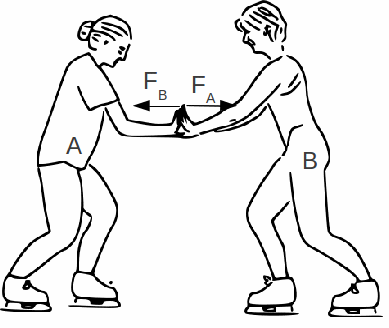Newton's third law of motion states, 'To every action there is an equal and opposite reaction'. This means that if an object A exerts a force on object B then object B exerts an equal and opposite force on object A. More crudely, when you push something, it resists being pushed and the force of resistance equals the force with which you push. When you stop pushing, the resisting force vanishes.
It is important to recognise the two forces act on different bodies. You push on the object and the object pushes on you. The two forces do not cancel each other out precisely because they act on different bodies. Suppose for example that you are a skater A, one of a pair of ice skaters.

You push on skater B with a force![]() and the other skater pushes back with a force
and the other skater pushes back with a force![]() Both skaters move away from each other. They experience the same force, acting in opposite directions so accelerate in opposite directions. If one skater has a smaller mass than the other, then since
Both skaters move away from each other. They experience the same force, acting in opposite directions so accelerate in opposite directions. If one skater has a smaller mass than the other, then since![]() that lighter skater will experience a larger acceleration.
that lighter skater will experience a larger acceleration.
Newton's third law is an aid to swimming, running and every sort of movement. When you are swimming, you push against the water with your arms and legs and the water pushes back, moving you forwards. When you go walking, you push backwads on the Earth with your feet, and the Earth pushes you forward. When a plane starts its engine, making air move towards the back of the plane, the air puses back on the plane, making it move forward.
